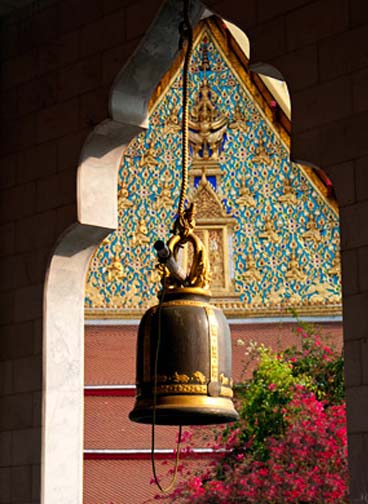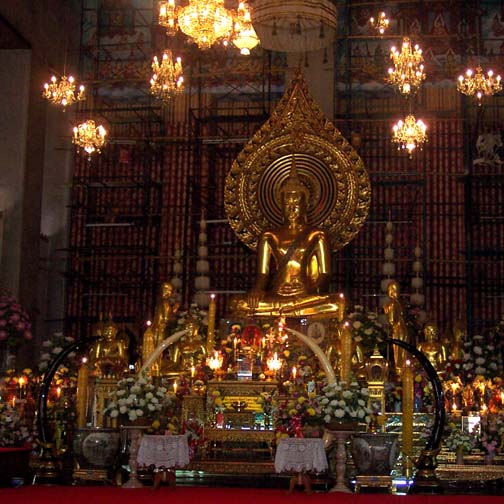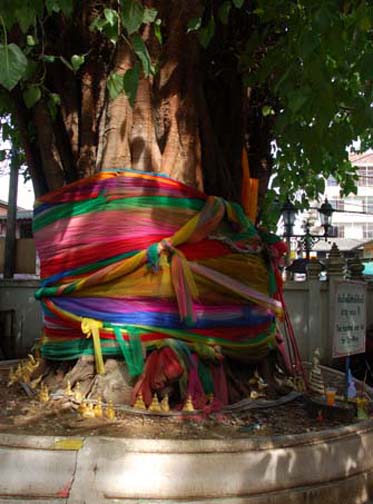Tags
There’s something about a wat whose name means Victory At War, or Conquer All Obstacles – depending on whose translation you prefer – that can’t seem to keep backpackers off its property that just doesn’t seem right. You could argue that The Buddha, who renounced all of his worldly goods and took off on his own journey of discovery, was a backpacker in his own right. But then he never went in for dreadlocks. And probably bathed occasionally.
It doesn’t help either that one of those conquer-worthy obstacles is that someone also named another wat in town the same. Not that a Thai would ever get the two confused. Because while both get their name from victorious foreign battles, only the one plagued by backpackers got its name from beating the Burmese bloody. And if there’s one obstacle Thais like to beat the crap out of, it’s the Burmese.
Only one of the two Wat Chana Songkhrams has a sign posted at its entrance reminding visitors to dress appropriately and not enter the temple in shorts, too. But then only one of the two wats has the great misfortune to be situated right next to Khaosan Road. And at that wat the belief is that if you make the proper offering to both the main Buddha image and the statue of Prince Maha Surasinghana (the dude who gets the props for bitch-slapping Burma) it will help you over come all difficulties in your life. There’s just a Buddhist twist.
Not being as anti-Burmese as Thais, the Buddha taught that it is better to conquer yourself than to win a thousand battles. So the blessing from Wat Chana Songkhram is assistance in conquering yourself. Then all sufferings and problems are easily overcome. Probably because in that 12-step program, you’d ditch the backpack and become a regular tourist. And learn the meaning of en suite bathroom. Or at least become enlightened enough to quit using a Buddhist temple as a short cut to the river.
The temple’s full name is Wat Chanasongkhram Rajaworamahaviharn. And if you enjoyed that tongue twister, the name of the principle Buddha image is Phra Buddha Norasee Trilokachet Mahetthisak Puchaniyachayantakhodom Boromsasada Anaworayan. And not Fucking Backpackers as you’d assume from the frequent mutterings of Thais worshiping there. But then karma being what karma is, there are a few temple-owned stalls in the courtyard that offer over-priced trinkets for sale to backpackers. So conquer that.
Less unclean visitors can instead purchase offerings for the Buddha and Prince Maha statues and thereby be blessed. Like getting to watch an angry monk chase improperly dressed backpackers off the property. ‘Cuz no one ever said the path to enlightenment couldn’t be enjoyable too. I’m not sure who you have to make an offering to to see what happens when a Burmese visitor enters the wat. But maybe Burmese only visit the other Wat Chana Songkhram. Since that one is only in honor of beating the Vietnamese and Cambodians.
Other than the occasional poorly dressed backpacker scurrying away from an angry ball of saffron, there’s not much to see at Wat Chana Songkhram. It’s of the standard white wall red tile roof temple design. It’s a mid-sized wat. And offers little that other nearby wats don’t do better. But there are several pair of elephant tusks decorating the ubosot’s altar, one of which are the standard ivory while the other is ebony (and if that forces that Michael Jackson song to play in your head, just remind yourself what a Thai is willing to do to get his hands on some elephant tusks these days. Even though Thais love elephants. Backpackers just don’t know how good they’ve got it.)
Built in the eighteenth century, the temple’s former name was Wat Klang Na, or Temple In The Paddy Field. It conquered that rather non-glorious moniker when it was restored and designated a Royal Temple in honor of the aforementioned and equally non-glorious loss by the Burmese in several skirmishes during the mid to late 1700s, one of which was gloriously named The Battle Of Nine Armies. Prior to its name change, when all it had to crow about was the paddy field it sat in, King Rama I appointed a group of Mon monks to care for the wat. And it became known as Wat Tong Pu. Just like another wat in Ayutthaya. So that similarly named wat problem is one the wat has never managed to conquer.
But stick a bunch of Mon monks in a wat and the next thing ya know the entire area will be crawling with Mon people. Which you’d think would be a problem when you are once again going to battle with Burma since that’s where they came from. But instead the local Mon formed a major troop in Prince Maha’s army, helped slaughter their relatives back home, and after returning to their paddy field King Rama I rewarded their endeavors by making the temple the center of the Mon sect of Buddhism. At least in Thailand. And at least until he made it a royal temple. Since conquering princes matter more than conquering Mon. None of which you’ll learn by visiting the wat. ‘Cuz the only sign they’ve posted is the one intended to conquer backpackers.
By the way, that the main Buddha image inside the ubosot is in the Subduing Mara position has nothing to do with the Burmese who were subdued. Or the backpackers one can only hope become subdued. Ditto for those elephants that donated their tusks to the altar display. It’s an homage to the Buddha conquering Mara. And while Thais generally hold the Buddha in great esteem and reverence, the proper offering to that image is three incense sticks, a lotus blossom, and a candle. While the image of Prince Maha gets the lotus blossom, the candle, and five incense sticks. Which should give you a hint about how reverent Thais are about conquering the Burmese. Even if they honor that feat in a wat that shares its name with another temple just a few miles away.
(Wat Chana Songkhram is best reached by boat on your way to a day of slumming it on Khaosan Road. Besides the elephant tusks, the monks’ quarters are the highlight of the wat. And there’s a few chedi out back worth a quick look too. Open from 6am to 6 pm, admission is free. To the wat’s great misfortune. ‘Cuz if they charged an entrance fee, they’d have a lot fewer backpackers to deal with.)





Khaosan Road, blechhhhhh. Why on earth would you go there under normal human circumstances.? It’s a breeding ground for everything from fleas to venereal disease.
. . . and horny backpacker boys out to experience the world (which for some reason always has to do with dick).
Ok, you win ! Some young blonde German hairy ass is ok for variety.
(after a razor has been applied)
As far as I can tell, one is Wat Chana Songkhram วัดชนะสงคราม แขวงชนะสงคราม (near Khao San) and the other is Wat Chai Chana Songkhram วัดชัยชนะสงคราม แขวงสัมพันธวงศ์ (in Chinatown). These might be mixed up in google maps and english language publications, but I assume this website http://www.วัด.ไทย/กรุงเทพมหานคร/ (in Thai, link is to list of all Wats in Bangkok sorted by area and name) gets it right.
Nice link, thanks.
You should do a English version, Christian.
I walked past many times, one day I will be in Khao San at the right time to visit the Wat (appointment with a boy who is late?). There are Wats that really have identical names, like Wat Promrangsi วัดพรหมรังษี.
Yeah, missed hook-ups are always a good reason to stop in a temple.
🙂